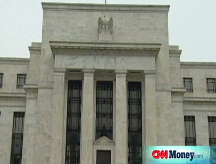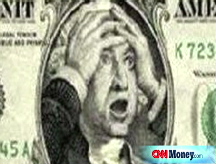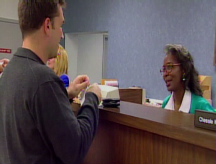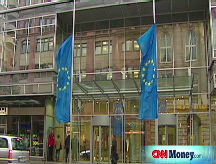Credit freeze: It's still on
Investors mull emergency rate cut. Bond prices turn lower after Treasury announces plan to sell more debt.
NEW YORK (CNNMoney.com) -- Credit markets remained choked after an emergency rate-cutting effort by six central banks offered some much-needed relief but was viewed as just one step toward fixing a massive problem.
"It was probably necessary but not sufficient to break the logjam," said Doug Roberts, chief investment strategist for ChannelCapitalResearch.com. "Right now you are not seeing any major change."
And government bond prices were mostly lower after the Treasury Department said it planned to sell $30 billion of debt over the next two days in an effort to meet upcoming borrowing needs, including the $700 billion bailout.
Treasurys whipsawed most of the session as investors mull the Fed's latest moves. "[It's] a fear factor [so] there is a lot of volatility," said Roberts.
Credit markets had been frozen ahead of the rate-cut announcement as lenders remained wary of taking on any potentially risky loans, leaving customers seeking loans in a lurch. The clogged pipelines have also hampered companies trying to cover everyday expenses, like payroll.
The Fed took its first steps toward helping thaw out the credit markets Tuesday, when it unveiled a new program aimed at offering to buy up commercial paper, a form of short-term funding that is crucial for many businesses.
While the efforts haven't gone unnoticed, it could take up to a month for the effects to be felt, and even that could be optimistic if another financial shoe drops.
The $700 billion bailout was the first step and the coordinated rate cut was a second move, "but I think they are going to have to do more," said William Larkin, portfolio manager at Cabot Money Management. He said it could take anywhere from two to four weeks without any financial institutions failing before the credit markets start to feel the effects.
Bond prices. Treasurys seesawed in the early going and turned decidedly lower after the Treasury Department unveiled plans to auction $30 billion worth of notes that expire in the year 2015.
"There are some papers out there that are in short supply, so the government is saying OK, fine, we are issuing more papers," said Michael Cheah, senior portfolio manager at AIG SunAmerica. While the maturity dates are not traditional, round measures, Cheah said the government is free to do whatever it sees fit. "They are trying to make the market flow smoothly," he explained.
The initial pop in bond prices after the Fed's rate-cut announcement suggested investors were not completely convinced that the move would be enough to prop up the economy. "The Fed cut just tells you the severity of the problem," said Larkin. Prices turned lower after the Treasury announced its plans, but the underlying anxiety about the economy's recovery persisted, adding to choppy trading.
The benchmark 10-year Treasury fell 1-9/32 to 102-26/32 and the yield rose to 3.65% from 3.5% late Tuesday. Bond prices and yields move in opposite directions.
The 30-year long bond fell 18/32 to 107-16/32 and its yield rallied to 4.06% from 4.03%. The 2-year note ticked 7/32 lower to 100-26/32 and its yield rose to 1.56% from 1.45% late Tuesday.
The yield on the 3-month Treasury bill was 0.64%, down from the 0.71% seen late Tuesday after bouncing between a low of 0.48% and a high of 0.77% throughout the day. The 3-month bill is considered one of the safest assets for investors to use as a holding bin for their cash during times of uncertainty.
The generally higher bond yields could also be partly due to the Fed stepping in to sell the short-term note in an additional effort to boost its borrowing base.
Market gauges. A key lending rate, the London interbank rate (Libor), was measured before the coordinated effort by central banks.
A spike in the overnight Libor rate indicated that the credit markets remained frozen. The overnight rate jumped to 5.38% from 3.94% the previous day, according to the British Bankers Association. Libor is a daily average of what 16 different banks charge other banks to lend money in London.
The 3-month Libor rate also surged, rising to 4.52% from 4.32% Tuesday, according to BBA.
An indicator of how willing banks were to lend to other banks, called the "TED spread," showed high prices of loans between banks. The TED spread measures the difference between the 3-month Libor and the 3-month Treasury bill, and is a key indicator of risk. The higher the spread, the bigger the aversion to risk.
The TED spread reached a record high of 4.02% Wednesday before retreating to 3.81% and after dipping as low as 3.46% Tuesday. Just over a month ago, the TED spread was only 1.04%.
Another gauge, the Libor-OIS spread set a record at 3.22%, before retreating slightly to 3.21%, and blowing past the record 2.97% spread reached Tuesday. The Libor-OIS spread measures how much cash is available for lending between banks, and is used by banks to determine lending rates. The bigger the spread, the less cash is available for lending.
Central banks team up: The fact that the rate cut was a coordinated effort between many central banks was a positive sign for the global financial crisis, according to one analyst, because nations will have to continue to work together to resolve the global credit crunch.
"It is optimistic that they were able to coordinate like that because a lot of people thought that would be difficult, so that was a positive," said William Larkin, portfolio manager at Cabot Money Management.
"That means there are discussions behind the scenes between all these central banks," said Larkin. And it will be important that they are "looking at this from a global perspective," he said.
At the same time, however, Larkin said that even such an effort was not going to be an endgame. ![]()






